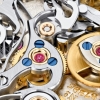How do I start on this
-
Recently Browsing
- No registered users viewing this page.
-
Topics
-
Posts
-
By Michalzeszen · Posted
Andy, why you betray me? I may have good news. I'll share later! -
Hi. I have been touching watches for quite some years, but haven’t before pretty recently decided to jump of the cliff by trying to do basic service for the first time. It is a simple Seiko 6602 I bought as a renovation movement. To be honest I struggled. Mainly because I wanted to do everything correctly and with all the right tools etc from the start. From just having basic tools I invested in quite a lot of things in order to dissemble, clean and lubricate the movement parts. I can say it was a journey. Taking care of the balance jewels looks really easy watching all the great videos, but god damn… I have been lucky and only shot away things that was found but come on. Anyway. I have now managed to “service” four movements and the result is what makes me want to keep doing this. The first movement was a Seiko 6602 and it was in a pretty bad shape. When I run it on the Timegraoher now I got an amplitude of 270 and in all positions it stays around +-2s. I have heard some “amateurs” saying this is a hobby you’ll get stuck to and I am already there. It doesn’t matter if it’s a fancy movement or a simple 6602. The feeling after been struggling and you see the result… it’s amazing! I am still in a state where I am confused and don’t know which watch press tool is best, or if I need the most fancy hand tools etc, but to be honest. This is so stimulating. Sorry for not really adding anything new to you all pros.
-
Casio normally put the movement number of the case back. Edit So it's a 709 Module (as Casio call then) you're looking for.
-
So to me you'd do more harm trying to remove that existing tube. Unfortunately nothings coming to mind at the moment as an east fix while keeping the screw down crown.
-
By Michalzeszen · Posted
I mean... I'm buying 15-30 USD watches and doing my best to bring them to life. I don't expect it to be perfect, but if you check the YouTube link I provided above, you'll realize I did an OK job bringing the case back to life. Will it be a precious collectible? Hardly. But for daily use, it is awesome. Attached.
-






Recommended Posts